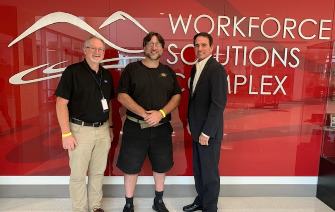CVCC, AHTC bonding through unique partnership, grant
Catawba Valley Community College recently received a $30,000 grant through a National Science Foundation (NSF) grant to partner with CVCC alumnus Pete Lohr and his local company Advanced Hydrogen Technology Corporation (AHTC).
12/10/2020

Catawba Valley Community College recently received a $30,000 grant through a National Science Foundation (NSF) grant to partner with CVCC alumnus Pete Lohr and his local company Advanced Hydrogen Technology Corporation (AHTC).
The grant and partnership will work to mutually benefit both CVCC engineering technology students and AHTC.
The NSF Phase II grant was presented to CVCC’s Gary Muller, Dean of the School of Workforce Development and the Arts, and Jim Thomas, Department Head of Engineering and Engineering Technologies, and will facilitate progress toward AHTC’s grant goals while simultaneously providing a substantial scientific learning experience for students at CVCC.
"It is very exciting for me to work closely with up-and-coming students with such fresh new perspectives on incorporating what they have been taught with real world applications,” said Lohr, who is AHTC’s president and chief technical officer. “It has been a very gratifying experience working with them.”
Lohr serves as the Principal Investigator on a NSF Small Business Innovation Research (SBIR) and Small Business Technology Transfer (STTR) Phase II grant to develop this new bonding technology.
As an NSF Phase II grantee, Lohr applied for and received $30,000 in supplemental funding intended to support partnership between small businesses and community college researchers and students.
AHTC is developing technology to bond dissimilar metals that cannot be joined through conventional methods. According to Lohr, his company is on the verge of creating a brand new manufacturing industry, and he expects AHTC to launch its first products in 2021.
AHTC’s initial product will be high-performance tungsten carbide tipped steel chisels for use in hydraulic breakers in the demolition, construction, excavating and mining industries. Tungsten carbide has 100 times more wear resistance than steel resulting in the ability to retain sharp cutting edges and therefore providing superior cutting performance saving money and time.
“It’s great to work together with a former student who is building his own business from the ground up,” Muller said. “He has worked very hard to get where he is today and we’re proud to be a part of that journey. Pete was one of our original shark tank winners when we started our program a decade ago.”
CVCC students are tasked with building a functional prototype of an automation system that can later be applied to AHTC’s impact bonding machine.
"I'm thankful to be given the opportunity to test out the skills that I have been honing here at CVCC in a real-world application,” said Cameron Church, an engineering student at CVCC. “It’s given me confidence in my transition from school into the workforce."
For more information about the programs at the CVCC School of Workforce Development and the Arts, please contact dean Gary Muller at gmuller@cvcc.edu.
Photo left to right: Jim Thomas, Department Head of CVCC’s Engineering and Engineering Technologies; Pete Lohr, President and Chief Technical Officer for Advanced Hydrogen Technology Corporation (AHTC); and Gary Muller, Dean of CVCC’s School of Workforce Development and the Arts.
# # #